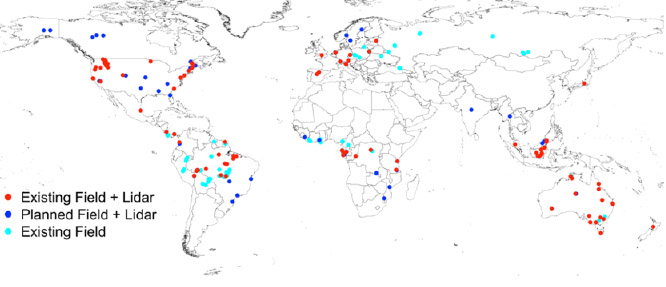
Focus Area on Aboveground Biomass Product Validation
Laura Duncanson, University of Maryland, USA
Kim Calders, Ghent University, Belgium
Neha Hunka, University of Maryland, USA
Aboveground Biomass Definition
Biomass, for the purposes of CEOS LPV, is defined as the dry mass of live or dead matter from tree or shrub (woody plant) life forms, typically expressed as a per area density (e.g. Mg of aboveground biomass per hectare). Thus, this does not include non-woody or belowground biomass. When discussing individual tree or plot total biomass (not density), the definition is Aboveground Biomass (AGB), whereas for plot or pixel level densities, as commonly estimated in mapped products, the definition is Aboveground Biomass Density, usually per hectare (AGB/ha). Below ground, woody debris or non-woody biomass, are also important components of the carbon cycle, but the former is not directly detectable from Earth Observing (EO) satellites, and non-woody and woody debris biomass are outside the scope of the CEOS LPV protocol.
Units:
Aboveground Biomass (AGB) is expressed as a mass, typically kg (kilogram), Mg (megagram or metric tonne) or Pg (petagram, or 109 tonnes).
Aboveground Biomass Density (AGBD) is expressed as a mass per unit area, typically Mg ha -1.
Highest Validation Stage Currently Reached for Satellite-derived Biomass Products
Currently, no biomass products are considered validated at higher than CEOS level 2 validation i.e. “product accuracy is assessed from a small (typically < 30) set of locations and time periods by comparison with in-situ or other suitable reference data”. This is in part due to the lack of high-quality reference data at appropriate spatial scales, particularly in areas of high biomass and/or uncertainty (much of the tropics).
A range of new and upcoming EO systems are designed specifically to map aboveground biomass and calibration/validation networks are currently being refined. We expect formalizing these networks will help us work toward the goal of reaching higher validation stages. For some of these missions, biomass products are the sole objective, and in such cases biomass product cal/val may not be a priority. It is quite possible that different EO sensors operating in different ways and using different algorithms, will produce different estimates of biomass. We need to be able to identify where and why biomass map differences occur, emphasizing the need for an agreed-upon and consistent system of biomass product assessment and intercomparison.
Validation Good Practices
The initial objective of the CEOS LPV Biomass focus area was the creation of a good practices protocol for validation of aboveground biomass products, including the development of a network of biomass reference measurement sites. The protocol effort took about 2 years to complete and includes contributions from over 50 authors and reviewers from multiple institutions and agencies. The protocol document was completed in late 2020, and was opened for comment from the wider community and independent reviewers before being finalized and endorsed by the CEOS in March 2021. The editing team is extremely grateful for the work of the many authors and reviewers that helped to bring together a wide-ranging and thorough exploration of the technical challenges of generating and using AGB estimates from satellite Earth observations.
The protocol is also intended to be a 'living' document, evolving as new data and understanding become available. Updates to the protocol are expected in 2024, with a revision of current chapters and a new chapter on biomass change assessments.
https://lpvs.gsfc.nasa.gov/PDF/CEOS_WGCV_LPV_Biomass_Protocol_2021_V1.0.pdf
Citation:
Duncanson, L., Armston, J., Disney, M., Avitabile, V., Barbier, N., Calders, K., Carter, S., Chave, J., Herold, M., MacBean, N., McRoberts, R., Minor, D., Paul, K., Réjou-Méchain, M., Roxburgh, S., Williams, M., Albinet, C., Baker, T., Bartholomeus, H., Bastin, J.F., Coomes, D., Crowther, T., Davies, S., de Bruin, S., De Kauwe, M., Domke, G., Dubayah, R., Falkowski, M., Fatoyinbo, L., Goetz, S., Jantz, P., Jonckheere, I., Jucker, T., Kay, H., Kellner, J., Labriere, N., Lucas, R., Mitchard, E., Morsdorf, F., Næsset, E., Park, T., Phillips, O.L., Ploton, P., Puliti, S., Quegan, S., Saatchi, S., Schaaf, C., Schepaschenko, D., Scipal, K., Stovall, A., Thiel, C., Wulder, M.A., Camacho, F., Nickeson, J., Román, M., Margolis, H. (2021). Aboveground Woody Biomass Product Validation Good Practices Protocol. Version 1.0. In L. Duncanson, M. Disney, J. Armston, J. Nickeson, D. Minor, and F. Camacho (Eds.), Good Practices for Satellite-
Derived and Product Validation, (p. 236): Land Product Validation Subgroup (WGCV/CEOS), doi:10.5067/doc/ceoswgcv/lpv/agb.001
Biomass Validation Reference Data Sets
A key recommendation of the CEOS Biomass protocol is for new and updated biomass measurements to enhance existing reference measurements (either to make them current, or improve them to meet the standards recommended in the protocol). There are many geographic domains with insufficient reference data, or where uncertainties in biomass products cannot be accurately estimated due to a lack of data. It is recommended that new datasets are routinely collected, in collaboration with existing networks, to both update and gap-fill existing reference datasets.

Proposed Forest Biomass Reference System - From Duncanson, et al., 2019.
As a result of the identified need for high quality biomass reference data, a new GEO-hosted activity was initiated in early 2021, called GEO-TREES: Forest Biomass Reference System from Tree-by-Tree Inventory Data. GEO-TREES is intended to support the establishment and development of global in situ biomass reference measurement sites, the Forest Biomass Reference System, to complement and validate existing and planned space-based forest biomass observation. These sites will provide integrated, multi-observational, multi-scale reference data to support global space-based forest biomass mapping and will include high-quality georeferenced data on forest biodiversity. The aim is to build on existing site networks (see below) that have high-quality long-term monitoring of forest aboveground biomass (tree measurements), as well as existing, planned or logistically feasible airborne data.
| Ecosystem | Plot Networks | Forest Inventory Methods |
| Tropical Forests | ForestPlots.net |
ForestGEO FAO |
| Temperate Forests |
NEON TERN |
ForestGEO NNRG FOS IIASA TERN USDA-FS |
| Dryland Forests | TERN | TERN |
| Mangroves |
Blue Carbon Initiative CIFOR |
|
| Boreal Forests | NEON FOS IIASA |
Review of: |
LPV Focus Areas
 
Meetings
Second Biomass Retrieval Inter-comparison eXperiment (BRIX-2), April 29 - 30, 2021.
Supersites and Biomass Validation Workshop, March 2nd - 6th, 2020, Canberra, Australia.
ForestSAT, 2-5 October, 2018, College Park, Maryland, USA. Register here.
Space-based Measurement of Forest Properties for Carbon Cycle Research, 6-10 Nov, 2017, International Space Science Institute, Bern, Switzerland
The terrestrial laser scanning revolution in forest ecology. Feb. 7, 2017, The Royal Society, Buckinghamshire, UK
- NASA Official: Sadashiva Devadiga
- Website Manager: Jaime Nickeson
- Last Updated: July 17, 2025


